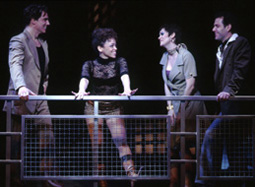Whenever I have the wonderful opportunity to view a musical one of two things takes place, either I simply love it or sometimes, it changes something within my understanding of the culture and world I'm a part of. Company was one of those reality altering experiences for me. This experience can vary from audience member to audience member. Many will find it deeply complex and powerful and then, perhaps you watch this show and don't find it enlightening at all. In the latter case, you must have only known perfect relationships throughout your life, congratulations. For the rest of us who have loved and lost and longed to love or maybe deciding to never love again, you and this show should have plenty to talk about, welcome.
There is a little detail about the play’s format that makes this musical rather unique. There is no plot. There are character changes and there is of course a meaning behind the words and music but the beauty of Company is managed without giving the audience a story line, no true beginning, middle or an end. It would be as if the scenes were shuffled in a deck, comprised of the memories of our main character, Robert (more on him later). Scene one could have been two months after scene four and scene five could have taken place years before scene one. It is this dynamic that makes this musical such an impressive case study of a man who is waiting for love.
Robert and his friends all reside in New York City. They range from upper middle class to much wealthier. The script tells us to set the play “NOW” which would suggest the present but if one were to really think about the different meanings of that word it would make sense to set it in any time between when it opened to the present date. For our production of Company we choose to set it on it’s original opening date, 1970.
Now we take a look at our main man, Robert. He is 35 years old and single. He lives alone and spends his time with his married friends and on occasion goes on a date. We know he has a job because we know he has his own apartment in New York City, we just don’t know what his job is. This is a smart move from Sondheim and Furth, it gives the character more universality. If Robert were, say, a doctor, the plays meaning of a man afraid of marriage would suddenly be applicable only to the professional aspect of the character. We also know nothing about his background. Giving us even a further feeling of this could be anyone. So pretty much the whole history of Robert is pretty vague, and it would appear that it is so for a reason, if, for instance, Robert was a doctor born and raised in Ohio this show would suddenly be about the struggles faced by a medical graduate from the Midwest. The less we understand about Roberts past the better we can relate to his matrimonial aversion. What we know plenty about are Roberts friends, Robert is something of a free psychologist to these characters. He’s an excellent friend and an overall likeable guy so this just causes all of them to spill their secrets, admit their faults and maybe even reveal their true desires. Next up are the girlfriends. These are the ladies that inspire Robert, the ones that move him and make him think about things he doesn’t always have to think about. The most we hear from Robert is on one of his dates and this speech gives us some of the answer to the question of why he isn’t married.
Sondheim and Furth have given us one of the greatest musical on humanity and the social norms we have created over the centuries. It does what only the best musicals do and that is to make the audience look at life from a different perspective. Viewing our world as we have never seen it before. This play has been translated and performed the world over proving that these ideas apply not only to upper middle class New Yorkers but these ideas on relationships run deep throughout all human experiences.
My purpose of writing this note is not to take away from the comedy and drama of the scenes and the beauty of the music, far from it. My ideas on Company are developments from years of familiarity with this show. I still remember where I was when I first saw Company, it was 2008, I was in the living room of my best friend drinking wine and when I first saw this show I wasn’t thinking about the impact this show made on humanity or the social criticisms it was pointing out, instead I simply went along for the ride. So for all of you seeing this show for your first time don’t worry too much on the deep understanding of this play, that will come with time. For now I welcome you to sit back, relax and enjoy the show.





















